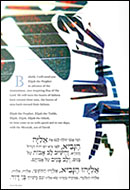Not Everything is Illuminated

Judaism is famously infatuated with text; and the New American Haggadah, with contemporary authors Jonathan Safran Foer and Nathan Englander listed as editor and translator, respectively, is the latest in a long line of love letters by Jews to their object of adoration. Its text-heavy pages intentionally lack conventional decoration and illustration. Instead we find words woven into vertical and circular threads, paragraphs painted into colorful compositions, and fonts fashioned into forms both ancient and daring. The editor required visual design, so he hired a typographer. Text becomes art.
The precise opposite is true of Judaism's oldest surviving Haggadot: Art becomes text, playing a pedagogic role equal to that of the written word. Illuminated medieval Haggadot contain folio after folio of colorful illustration. The function of these images is more than aesthetic: they depict biblical stories and rabbinic traditions that would otherwise be excluded from the Passover conversation. The standard Haggadah text passes over much of the biblical Exodus and even makes scant mention of Moses. It is precisely where these words are lacking that Haggadah images fill in the narrative.
Take, for example, Passover's archetypal moment of resistance and heroism, Moses' killing of the Egyptian taskmaster. There is no mention of it in the Haggadah text. We can speculate on why the original compilers of the Haggadah excluded it, but clearly their descendants wanted it back. The Golden Haggadah (ca. 1320), Sister Haggadah (ca. 1350), and Hispano-Moresque Haggadah (ca. 1350) all vividly illustrate the scene.
The Hispano-Moresque Haggadah presents a particularly dramatic version of the event. It begins with a full-page image of Egyptians hurling Israelite babies into the Nile. One child has been thrown into the river head-first; we see his small legs still protruding upward through the water's surface. In the next folio, illustrating the taskmaster's death, we do not find the murder itself; instead, we see Moses burying the slain Egyptian, whose two lifeless legs—the artist's striking parallel—still protrude upward out of the sand. The message is remarkable and entirely original: In slaying the cruel Egyptian, Moses does not merely avenge a single abused slave but retaliates against the entire system of Pharaonic tyranny. What the callous Egyptians visited upon Israelite children, Moses revisited upon them. What the textual commentary failed to state, Jewish art dared to depict.
In addition to depicting the plain biblical text, Haggadah art freely incorporates the creative world of midrash. Thus, the Dragon Haggadah (ca. 1275) presents a bizarrely graphic image of a Jewish woman giving birth to the last of six newborns. The text reports, sparely, that "the Children of Israel were fruitful and increased abundantly" in Egypt. The image, more vividly and without words, conveys the classic midrashic understanding of Hebrew fecundity.
But more than merely replicating midrashic tropes, these illuminated Haggadot aspire to unlock their symbolic power. The Sarajevo Haggadah illustrates the concluding moment of Genesis—Joseph's embalmed body in its coffin—with a colorful midrashic expansion, that the Egyptians sank Joseph's coffin into the Nile as a kind of cadaverous good luck charm. The image is composed of Joseph in an open gold box, hovering over a wavy blue river, surrounded by human figures on both sides. This picture immediately borders an illustration of baby Moses rescued from the Nile—composed of Moses in an open gold box, hovering over a wavy blue river, surrounded by human figures on both sides. These images convey the symbolic genius of the midrash. In the midrashic imagination, Joseph and Moses are symbols of the people Israel. The Jewish descent into slavery begins with a lifeless Joseph sunk into Egypt's Nile, while Jewish salvation commences with a newborn Moses raised up from the watery depths.
Indeed, these medieval illuminations can raise, as powerfully as text, the most essential questions in Jewish theology. Both the Golden Haggadah and Nuremberg Haggadah (ca. 1450) illustrate Exodus 14:8: "The Children of Israel left [Egypt] with an upraised hand." In the Nuremberg Haggadah, the Israelites' upraised hands bear the spears and swords of medieval insurrection. This Exodus is armed: God leads the charge, but His people are ready to fight. In contrast, salvation in the Golden Haggadah is a faith-based initiative: The Israelites exit Egypt with their hands upraised in supplication and praise to God. Their Egyptian pursuers, pictured nearby, foolishly rely on force of arms; the Jews merit redemption through the power of prayer alone.
The original Exodus is a model of Jewish salvations to come, so these vastly different images of the Jewish past reflect alternative visions of the Jewish future. When the creators and readers of the Nuremberg Haggadah contemplated their own redemption, they likely saw a legion of armed Jews; those who produced and cherished the Golden Haggadah awaited the moment at which Hebrew piety would finally prove sufficient. Jewish art talks Jewish theology.
In many ways the New American Haggadah lives up to its name: new layout, innovative translation, creative commentaries, and typefaces so vibrantly crafted as to communicate the power of art. But not all "news" is good news. Excising imagery from a Haggadah is an unfortunate break with a Jewish tradition both colorful and profound. Those seeking a more complete appreciation of Jewish creative force can look to Michael Shire's Illuminated Haggadah or the recent, masterful Schechter Haggadah. The latter incorporates and elucidates 115 illustrations, compiled from dozens of manuscripts ranging from the 13th to the 21st century. The translation may be less poetic, the commentary less ostentatious, and the typeface scandalously reminiscent of Microsoft Word; but in these illustrated Haggadot we rediscover Jewish art so imaginatively composed as to communicate the power of text.
Ben Greenfield is a fellow at the Tikvah Fund.
Comments are closed for this article.




